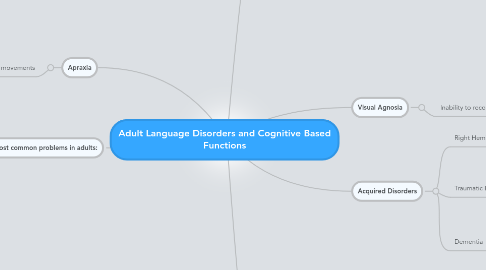
1. Apraxia
1.1. Inability to perform purposeful movements
2. 3 most common problems in adults:
2.1. Delirium
2.1.1. Develops over 2-3 Days
2.1.2. More common in males
2.1.3. Can be caused by bacterial meningitis
2.1.4. Can also be caused by unscheduled surgery
2.2. Depression
2.3. Dementia
3. Alzheimer's Disease
3.1. A chronic progressive degenerative disease.
3.2. Suffered by 4.5 million Americans
3.3. Usually begins at age 65
3.4. Risk factors include atherosclerosis, high cholesterol and diabetes
3.5. Familial cases of AD are rare
3.6. 3 categories are mild, moderate, and late
3.7. Redirection, distraction and reassurance help with AD
4. Aphasias
4.1. Is a disturbance in language after language has been learned.
4.2. Results from neurological injury to left side of brain
4.3. Includes disturbances of receptive or expressive language ability
4.4. 7 Types:
4.4.1. Wernicke's
4.4.1.1. Site: temporal lobe
4.4.1.2. Fluent, meaningless speech, paraphasias, naming difficulty
4.4.2. Broca's
4.4.2.1. Site: Frontal Lobe
4.4.2.2. Nonfluent, effortful articulation, telegraphic speech, short phrases, impaired prosody, apraxia of speech
4.4.3. Transcortical Motor
4.4.3.1. Site: prefrontal cortex
4.4.3.2. Nonfluent, difficulty initiating speech, paraphasias, short utterances, good repetition
4.4.4. Anomic
4.4.4.1. Site:Angular gyrus
4.4.4.2. Fluent, word-finding problems
4.4.5. Global
4.4.5.1. Site: multiple lobes and lesions
4.4.5.2. Nonfluent, delayed, naming problems
4.4.6. Conduction
4.4.6.1. Site: Arcuate fasciculus
4.4.6.2. Fluent, imitation problems, naming difficulty, normal prosody
4.4.7. Transcortical Sensory
4.4.7.1. Site: Parieto-occipital region
4.4.7.2. Fluent, meaningless speech, paraphasias, naming difficulty
4.5. Common speech-language problems in aphasia
4.5.1. Agrammatism
4.5.1.1. leaving out grammatical markers
4.5.2. Word-finding problems
4.5.2.1. Inability to come up with words
4.5.3. Telegraphic speech
4.5.3.1. Phrases made up of mostly content words
4.5.4. Jargon
4.5.4.1. Production of meaningless language
4.5.5. Effortful articulation
4.5.5.1. Physically laborious speech
4.5.6. Initiation difficulties
4.5.6.1. Difficulty initiating speech
4.5.7. Comprehension deficits
4.5.7.1. Compromised understanding of language
4.5.8. Impaired repetition
4.5.8.1. Inability to repeat sounds
5. Acquired Disorders
5.1. Right Hemisphere Dysfunction
5.1.1. Damage to brain tissue due to loss of nutrients and oxygen
5.1.2. Stroke, Illness, Disease
5.2. Traumatic Brain Injury
5.2.1. Damage to brain due to closed or open head injury
5.2.2. Car accident, fall, sports, violence
5.3. Dementia
5.3.1. Decline in language due to nervous system dysfunction
5.3.2. Neurological diseases, and multiple strokes
